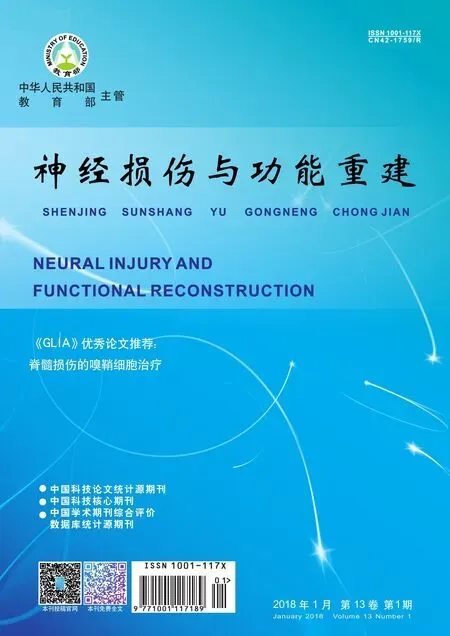Cell therapy for spinal cord injury with olfactory ensheathing glia cells(OECs)
2018-01-31mezRMnchezMYPortelaLombaGhotmeBarretoGESierraMorenoFloresMT
Gómez RM,Sánchez MY,2,Portela-Lomba M,Ghotme K,Barreto GE,Sierra J,Moreno-Flores MT
1.Fundación de Neuroregeneración en Colombia,Grupo de investigación NeuroRec,Bogota D.C,Colombia.
2.Maestría en Neurociencias,Universidad Nacional de Colombia,Bogota D.C,Colombia.
3.Facultad de CC Experimentales,Universidad Francisco de Vitoria,Pozuelo deAlarcón,Madrid,Spain.
4.Facultad de Medicina,Universidad de la Sabana,Chía,Colombia.
5.Departamento de Nutrición y Bioquímica,Facultad de Ciencias,Pontificia Universidad Javeriana,Bogota D.C,Colombia.
6.Instituto de Ciencias Biomédicas,UniversidadAutónoma de Chile,Santiago,Chile.
7.Facultad de Medicina,UniversidadAutónoma de Madrid,Madrid,Spain.
The prospects of achieving regeneration in the central nervous system(CNS)have changed,as most recent findings indicate that several species,including humans,can produce neurons in adulthood.Studies targeting this property may be considered as potential therapeutic strategies to respond to injury or the effects of demyelinating diseases in the CNS.While CNS trauma may interrupt the axonal tracts that connect neurons with their targets,some neurons remain alive,as seen in optic nerve and spinal cord(SC)injuries(SCIs).The devastating consequences of SCIs are due to the immediate and significant disruption of the ascending and descending spinal pathways,which result in varying degrees of motor and sensory impairment.Recent therapeutic studies for SCI have focused on cell transplantation in animal models,using cells capable of inducing axon regeneration like Schwann cells(SchCs),astrocytes,genetically modified fibroblasts and olfactory ensheathing glia cells(OECs).Nevertheless,and despite the improvements in such cell-based therapeutic strategies,there is still little information regarding the mechanisms underlying the success of transplantation and regarding any secondary effects.Therefore,further studies are needed to clarify these issues.In this review,we highlight the properties of OECs that make them suitable to achieve neuroplasticity/neuroregeneration in SCI.OECs can interact with the glial scar,stimulate angiogenesis,axon outgrowth and remyelination,improving functional outcomes following lesion.Furthermore,we present evidence of the utility of cell therapy with OECs to treat SCI,both from animal models and clinical studies performed on SCI patients,providing promising results for future treatments.
cell therapies;cell transplantation;neuroregeneration;olfactory ensheathing glia cells;spinal cord injuries;transplantation
(编译:王晶)
